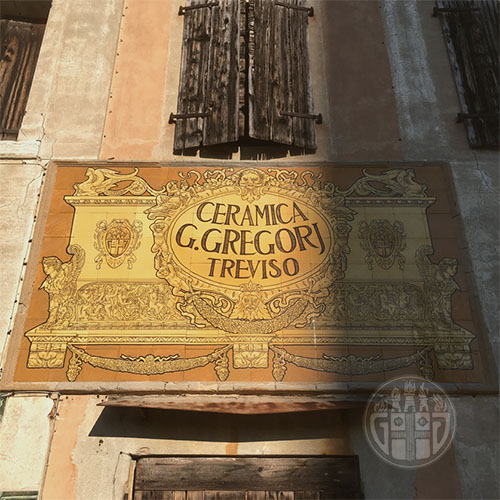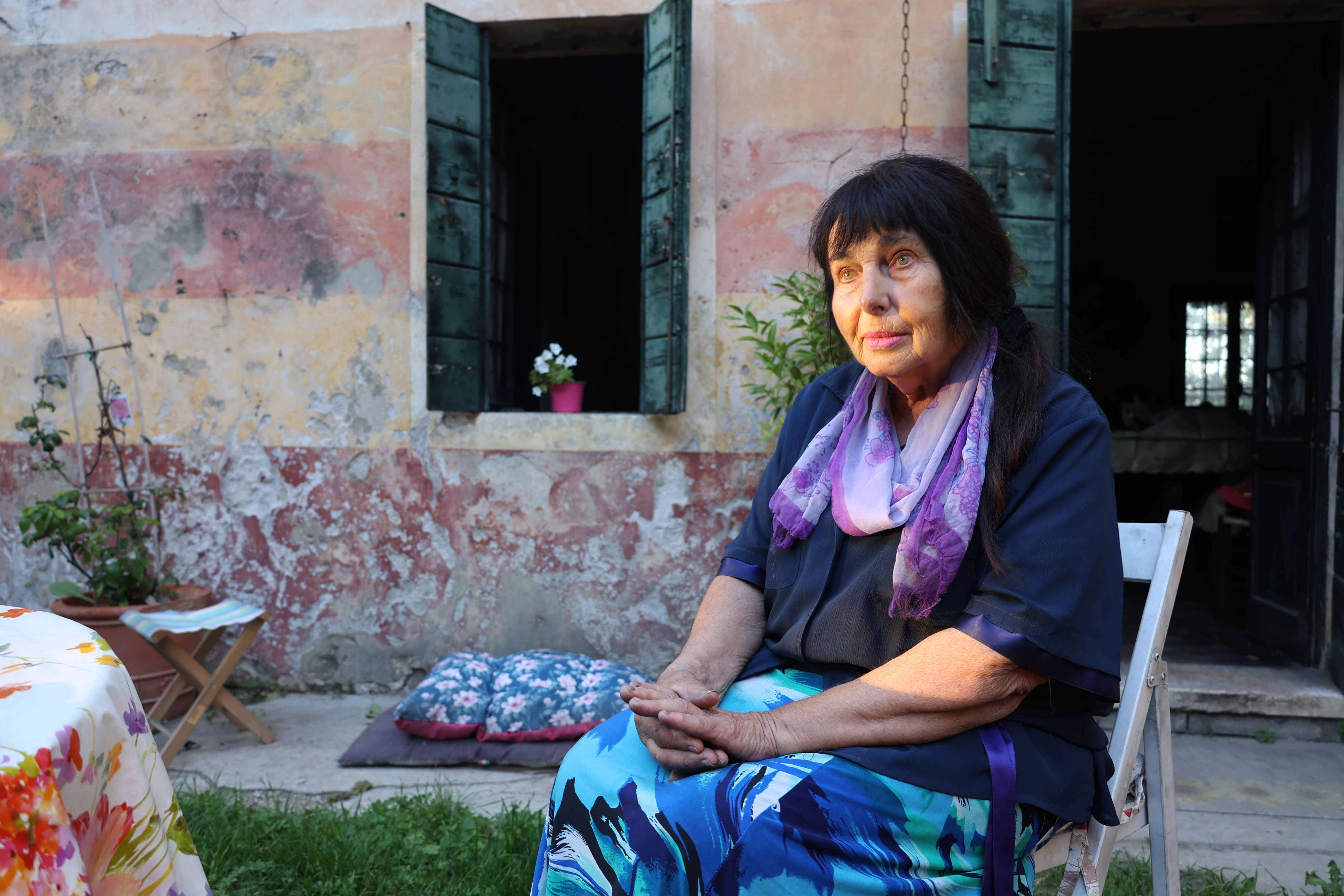
Guerra Gregorj Kiln | Spring FAI 2019
«... “The Guerra Gregorj Kiln, located in Sant'Antonino on the outskirts of Treviso, was the iconic venue of the 2019 Spring FAI Days in the Treviso area, the last event before COVID-19. Over the two days, we witnessed a true "onslaught" of visitors of all ages, genders, and social backgrounds; more than 1500 people arrived at the gates of the property that the Gregorj family generously opened to the public
I would like to emphasize that the contribution of Luisa Gregorj, her nieces Maria Beatrice and Regina Luisa, as well as Giorgio Rossi and the co-owners Anna and Ernesto Rossi Scarpa Gregorj, was crucial in creating a welcoming atmosphere. They made the hundreds of visitors feel at ease, who were immediately divided into groups by the FAI volunteers.
Luisa Gregorj embodies the historical memory of the site; she has authored several publications on the furnace and the artists who were connected to it, thus representing the added value that was conveyed to the guests. Everyone paid tribute to the woman who, in the director's villa, meticulously illustrated the precious objects on display, each laden with history and testimonies of a world now lost. Occasionally, a former worker who had once been employed at the site would timidly appear, such as Elsa Paro, who was able to revisit the places of her childhood and embrace the descendant of her first employers. However, the two days were not solely dedicated to nostalgia. Thanks to the collaboration with Emanuela Sorbo, a professor of architectural restoration at the University Institute of Architecture of Venice, many young students presented their projects for the reuse of the furnace's structures to the public, displayed in the brick-making area.
Other invaluable guides included architects Laura Dal Pos and Gianluca Spironelli, who graduated in 2028 with a thesis on the complex. Architect Beatrice Ciruzzi also contributed with her restoration and revitalization projects for parts of the furnace and was a valuable asset in organizing the event. I would also like to highlight the invaluable contribution of the students from the Antonio Canova High School in Treviso, coordinated by their tutors and Professor Susanna Dei Rossi. On this occasion, we observed that industrial archaeology generates enormous interest in the community, extending beyond art and economic and social history enthusiasts. In this case, the mediation of Abbot Luigi Bailo played a crucial role, as it led Gregorio Gregorj to gather in the artists' hall figures such as Alberto and Arturo Martini, Luigi Serena, Arturo Malossi, and later Giuseppe Santomaso. Their work complemented the production of construction bricks with stunning artistic objects that anticipated the world of design, which would emerge decades later. The Guerra Gregorj Furnace, starting as a simple manufacturing site, succeeded in elevating and ennobling the ceramic industry, transforming it into a form of high artistic expression. This achievement was made possible by experimenting with materials and new processing techniques. Evidence of this is the complex structure of the Hoffmann kiln, the true centerpiece of the complex, and visiting its interior was the most moving moment of the entire tour.
The complex closed its doors in 1963 and was declared a “Precious testimony of a vanishing old world” in the decree issued by the Ministry of Cultural Heritage on June 10, 1987. We therefore hope that the interest sparked by the FAI Spring Days in 2019 will serve as an encouragement to initiate a careful reuse of the complex, introducing new functions that still manage to preserve and convey the significance of a site that stands as a symbol of entrepreneurship and labor in our region.”»
Mario Gemin, Head of the FAI Delegation of Treviso.

Documentary film by Dimitri Feltrin:
“La fornace degli artisti – Storia sentimentale della Fornace Guerra-Gregorj di Treviso”
«... “La fornace degli artisti " is a film that tells a fundamental chapter in the history of manufacturing, art, and Treviso's culture. "A story that fascinated me greatly but whose memory is quickly being lost," says the director and producer, Dimitri Feltrin. "I would like to thank Mrs. Luisa Gregorj for sharing it with me and allowing me to tell it to all those who wish to listen. My dream is that the Guerra-Gregorj Furnace, which is now a fascinating but decaying example of industrial archaeology, will soon shine again and bustle with life, as it did between the 19th and 20th centuries. I would also like to thank the Treviso Film Commission, CGIL Treviso, and the Association of Friends of the Museums and Monuments of Treviso, because without their contribution, this work would not have come to life. Finally, I extend my gratitude to all the institutions that sponsored the film, giving it credibility and prestige”»
Dimitri Feltrin


The film is a sentimental journey through the history of the fascinating Guerra-Gregorj Furnace in Treviso.
This magical place was a meeting point, a workplace, and a source of inspiration for the greatest artists of early 20th-century Treviso.
A story of beauty and passion, but also of decay and pain—without ever abandoning hope for the future.
Luisa Gregorj meticulously preserves the memory and guides the viewer to discover one of the most important places in the cultural and artistic history of Treviso.
Through her narration, one can learn anecdotes and curiosities tied to the history of the ceramic factory: from the turbulent working relationship between Arturo Martini and his employer Giorgio Gregorj, to Regina Gregorj and Nando Salce’s stay in the Gregorj summer residence in Lancenigo during World War II, and the abbot Bailo’s passion for ancient pottery fragments...
The project was carried out with the financial support of the Treviso Film Commission, CGIL Treviso, and the Association of Friends of the Museums and Monuments of Treviso.
It is endorsed by the Province of Treviso, the City of Treviso, and the City of Villorba, as well as by important institutions in the historical, cultural, and economic fields such as FAI – Treviso Delegation, ISTRESCO, MIC – International Museum of Ceramics in Faenza, the Benetton Foundation for Studies and Research, and the Treviso Belluno Chamber of Commerce.
THE DEDICATED WEBSITE:
https://www.lafornacedegliartisti.it/
Publications
For Gregorio Gregorj, the study was a reason for reflection on the causes of certain social ills that affected the region, including Small industries among farmers, Ed. Zoppelli, Treviso 1897; Le calzature economiche per le classi povere Ed. Italia Agricola; L'emigrazione dei contadini dal Veneto Ed. Zoppelli, Treviso 1898; The horizons of Italian emigration Ed. Zoppelli, Treviso 1901.
But the study and search for traces of the past between ideals of beauty, aesthetic changes, charm and love for decorations led Luisa Gregorj, daughter of Giorgio Gregorj, to collect all the documents from the family archive in order to draw up Dietro le quinte, Artisti nella Fornace Guerra-Gregorj a Treviso, Giacobino Editore 2001. This last book contains the history of the furnace but also that of his own family and the artists who worked there.
.jpg)
Gregorj Gregorio, Fornace Ceramica Gregorio Gregorj Treviso, Stabil.Tipografico Ditta L. Zoppelli, Treviso
.jpg)
Gregorj Gregorio, Gli orizzonti della emigrazione italiana Ed. Zoppelli, Treviso 1901
.jpg)
Gregorj Luisa, Dietro le quinte, Artisti nella Fornace Guerra-Gregorj a Treviso, Giacobino Editore 2001
.jpg)
Japanese art file purchased by Gregorio Gregorj
Some family customs
On the occasion of the wedding of Regina Gregorj and Nando Salce on 2 September 1899, Giorgio Gregorj had prepared a ceramic tile with a lovely dedication. The artist is unknown but it is thought to be attributable to Vittorio Celotti who was very fond of blue backgrounds.
The accountant Nando Salce, a man of culture from Treviso, collector of countless advertising posters collected over more than half a century until 1962 and which he would then leave to the Ministry of Education, constituting a unique cultural heritage of its kind in Europe.

Regina, known as Gina Gregorj and the engineer Vincenzo Gregorj, brother of Gregorio Gregorj

Inaugural tile for the wedding of Gina Gregorj and Nando Salce
